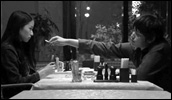Door to the Sea
- Year
- 2010
- Original title
- Umi e no Tobira
- Japanese title
- 海への扉
- Director
- Cast
- Running time
- 70 minutes
- Published
- 13 May 2011



by Tom Mes
When the Tokyo University of the Arts founded its Graduate School for Film and New Media in 2004, it was part of a wave of new film schools that opened their doors around the turn of the millennium. This formed a notable break with any past era in Japanese cinema, in which the apprenticeships of the studio system had long formed the sole model of film education.
Spearheading this development was The Film School of Tokyo, which stood out from the crowd by appointing a bevy of internationally reputed filmmakers to its faculty, including Kiyoshi Kurosawa, Hirokazu Koreeda and Shinji Aoyama. The Tokyo University of the Arts managed to one-up its smaller rival by not only luring Kurosawa into its fold but also by convincing arguably the most lauded filmmaker of his generation, Takeshi Kitano, to add a teaching position to his already overflowing itinerary.
While celebrity professors may attract publicity and student hopefuls, the long-term viability of a film school rests entirely on the fates that await its alumni. Naoki Kato stood out among the first batch of graduates with A Bao A Qu (2007), an intriguingly narrated reconstruction of a murder case. Although it took Kato four years to deliver the follow-up, and his first professional feature, Abraxas (Aburakusasu no Matsuri, 2011), this emotional story of a punk musician turned Buddhist monk more than fulfilled the promise of his graduation film.
The 11th edition of Germany’s Nippon Connection festival featured a spotlight on the most recent Tokyo University of the Arts harvest, with films by five graduates from the class of 2010. All of these (and in particular Paul Young’s Sheep in the Night / Mayonaka no Hitsuji and Hiroshi Gokan’s Teto) showed a good deal of talent and promise. However, it was Reiko Ohashi’s Door to the Sea that received a special mention from the Nippon Visions jury (which included yours truly) for “daring to be conventional”.
“Conventional” is rarely a word used in a positive sense, yet in the case of Ohashi’s film it seems perfectly suited to summing up the strengths of a work of cinema that shows a maturity beyond what a film school graduate could reasonably be requested of being capable of delivering. The director seems to have inherited her mentor Kiyoshi Kurosawa’s love for a classical directorial style, clear and concise and devoid of fuss and frills, echoing a long tradition of (mostly American) filmmakers, from Clint Eastwood via Richard Fleischer to Don Siegel.
To be clear, Door to the Sea is certainly not an action film. Its love-triangle narrative revolves around paperboy Ken (Kaneko), who, lacking the funds to pay for tuition, attends university classes in secret. A girl named Haru (Tomita) notices his ghostly presence, but it is not until she catches him stealing a prehistoric bone fragment from the science lab that a spark ignites the chemistry between them. A handsome young biology professor (Ohura) figures out Ken’s secret and decides to step into the role of mentor – for reasons not entirely devoid of self-interest, particularly toward Haru.
This is a storyline that won’t immediately call to mind the Hollywood B’s, but one gets the impression from Ohashi’s confident directorial style that here is a director destined for a solid career as a versatile professional filmmaker – yet one whose every work will nevertheless be a personal one. Think Yuki Tanada (who I’ve compared to Don Siegel on past occasions, for much the same reasons), Takashi Miike or, indeed, Kiyoshi Kurosawa.
Ohashi’s confidence can also be gauged from the casting. The three unknown leads are all impressive, with young Rio Tomita a particular standout as nonconformist collégienne Haru. But it’s the presence of Takeshi Kitano acolyte Guadalcanal Taka (recently seen as the despotic mayor in Miike’s magnificent Zebraman 2), cast wholly against type as a greying Nestor who functions as this film’s Greek chorus, and of long-time Kurosawa muse Yoriko Doguchi (The Excitement of the Do-Re-Mi-Fa Girl, Suit Yourself or Shoot Yourself, Charisma) as Ken’s negligent mother, that testify to this young director’s deft handling of actors of any calibre.
Time will tell whether Reiko Ohashi will be given the opportunities to fulfil her potential. The Japanese film industry today is not the most hospitable environment for a novice filmmaker, yet it is clear from Door to the Sea that the basic qualities producers look for in a young director (reliability, professionalism, determination) are ones Ohashi possesses. Like the filmmakers mentioned above, she can meet the industry’s expectations – and subvert them at the same time.